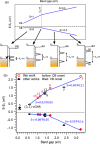Width-Dependent Band Gap in Armchair Graphene Nanoribbons Reveals Fermi Level Pinning on Au(111)
- PMID: 29049879
- PMCID: PMC5789393
- DOI: 10.1021/acsnano.7b06765
Width-Dependent Band Gap in Armchair Graphene Nanoribbons Reveals Fermi Level Pinning on Au(111)
Abstract
We report the energy level alignment evolution of valence and conduction bands of armchair-oriented graphene nanoribbons (aGNR) as their band gap shrinks with increasing width. We use 4,4″-dibromo-para-terphenyl as the molecular precursor on Au(111) to form extended poly-para-phenylene nanowires, which can subsequently be fused sideways to form atomically precise aGNRs of varying widths. We measure the frontier bands by means of scanning tunneling spectroscopy, corroborating that the nanoribbon's band gap is inversely proportional to their width. Interestingly, valence bands are found to show Fermi level pinning as the band gap decreases below a threshold value around 1.7 eV. Such behavior is of critical importance to understand the properties of potential contacts in GNR-based devices. Our measurements further reveal a particularly interesting system for studying Fermi level pinning by modifying an adsorbate's band gap while maintaining an almost unchanged interface chemistry defined by substrate and adsorbate.
Keywords: Fermi level pinning; Ullmann coupling; dehydrogenation; density functional theory; graphene nanoribbon; on-surface synthesis; scanning; tunneling microscopy and spectroscopy.
Conflict of interest statement
The authors declare no competing financial interest.
Figures





References
-
- Xiang C.; Cox P. J.; Kukovecz A.; Genorio B.; Hashim D. P.; Yan Z.; Peng Z.; Hwang C.-C.; Ruan G.; Samuel E. L. G.; Sudeep P.; Konya Z.; Vajtai R.; Ajayan P. M.; Tour J. M. Functionalized Low Defect Graphene Nanoribbons and Polyurethane Composite Film for Improved Gas Barrier and Mechanical Performances. ACS Nano 2013, 7, 10380–10386. 10.1021/nn404843n. - DOI - PubMed
-
- Mazzamuto F.; Hung Nguyen V.; Apertet Y.; Caër C.; Chassat C.; Saint-Martin J.; Dollfus P. Enhanced Thermoelectric Properties in Graphene Nanoribbons by Resonant Tunneling of Electrons. Phys. Rev. B: Condens. Matter Mater. Phys. 2011, 83, 235426. 10.1103/PhysRevB.83.235426. - DOI
Publication types
LinkOut - more resources
Full Text Sources
Other Literature Sources
Miscellaneous

